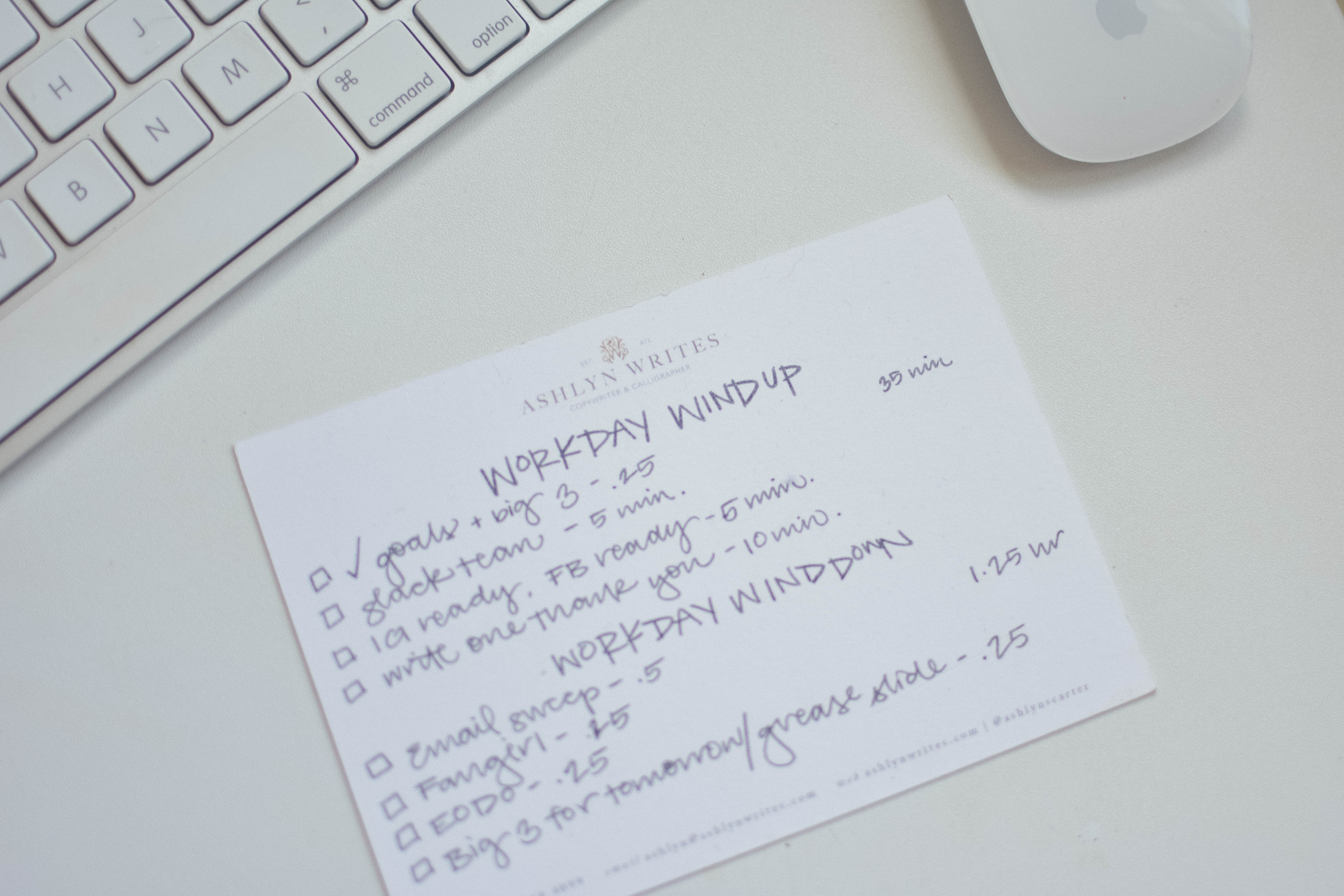Let’s talk about how to organize your small business … because I’m guessing our brains work similarly.
“I don’t know if I could be in your head for a day,” my husband Wes told me over pizza in Oakhurst Village one Friday night. “You’ve got a new idea, like, every hour. Whew.”
I blinked. Every hour? You think it’s every hour!? Try every ten minutes …
Y’all, it’s true. Between my ENFJ Myers-Briggs personality, open struggle with anxiety, and chosen career field, I’m wired to constantly consume media and information, which leads to a rapid-fire stream of ideas in my head.
I can only imagine my fellow entrepreneurs and worker bees—whether you own a business or just get after it at work—feel the same way, too. We’re dreamers, innovators, and pioneers. Idea ADD is a thing.

The silo of information is something I always find fascinating. Back in January, I told my mastermind sisters that I think studying productivity is my side hustle.
Here are six ways you can get organized during your workday. (I really challenged myself to include things that you can ACTUALLY implement in one day. I mean, you may have to prep for them, but I’m not going to tell you to metaphorically clean out your business brain from attic to basement in a day. That’d be impossible.)
Instead, I’m focusing on six things you can do—to organize your small business— within the course of ONE day in the home office to crank out a solid workday given your visionary, day-dreaming mind …
… PLUS, a video of behind the scenes of how I track my time & my freebie time tracker!
Let’s jump in to how to organize your small business!
No. 1| Design a Workday Wind-up & Wind-down Routine
Okay, you’ve probably (maybe?) heard of The Miracle Morning—I think we’ve all heard the stats: Science backs that that willpower is like a muscle that becomes fatigued from overuse, and people who wake up early typically perform better in many different capacities.
I love me some Michael Hyatt, and I got the idea of a workday wind-up and wind-down from one of his courses. I even wrote ideal morning routine and evening routine on note cards and taped them where I can see them in my closet!
Do I hit everything five days a work week? Heck no, techno (do the kids still say that?).
BUT, it’s a bullseye. And I hit around it a lot.

How to Organize Your Small Business Homework Task #1 :Design your own wind-up and wind-down routine! It doesn’t have to look at all like mine. These are just little things that help ME stay centered, and I love them.
Need more assistance in setting up your routine in? I’ve got you covered 😉 Check out these posts:
- My Productive Morning Routine: 7 Things I Do Every Day
- My Evening Routine: The Work-to-Rest Wind Down
- My Quarantine Routine
No. 2| Hack Your Sweet-Spot Time
I heard Jared Loftus on a Mavenly + Co. podcast say one time that he loves going to coffee with young, budding entrepreneurs—if they’ll meet him at 6:30 a.m.
6:30 in the morning. I mean, I’m a member of the Early Risers Club, but I’ve hardly had my coffee by 6:30!
Justin knows he’s in his creative groove in the mornings and afternoons, and as an entrepreneur, works to protect that fiercely, even to the point of weeding out mentees who may not be so invested in speaking with him that they’re willing to rise before the sun.
The One Thing by Gary Keller is a fabulous book that helps to hit on this point a bit more: Keller advocates that entrepreneurs spend at least FOUR hours a day doing that one, really important thing they have to do, like:
Calligraphy orders
Copywriting for clients
Painting
Editing
Designing
etc.
Whatever the “thing” you get paid the big bucks for is, spend concentrated time on it, and allow the rest of the day to ebb and flow. Keller says “be a maker in a morning, a manager in the afternoon.”
In my own life? I write best early in the morning, late in the afternoon or at night.
I write miserably in the 12-3 p.m. window. Miserably. I would rather nap.
So, I hack my sweet spot time—this is KEY. I make sure the first four hours are relatively uninterrupted with meetings, calls, or anything else, and I focus on moving the needle forward in whatever task is batched for that day. This has looked like carving out the morning block for my writing projects. Most days, I get in a quick workout before I’m “on enough” to say no, have my quiet time, and then knock out my biggest tasks of the day before noon.
In the late afternoon, my mind is foggy, and that time is best for admin tasks.
How to Organize Your Small Business Homework Task #2: Find when you come alive and guard at that time. When do you feel most creative during the day? When are you most excited about work? When are you least excited about work, and what mindless tasks—or just tasks that don’t take every creative ounce of you,—can you put in that block? For example, responding to Instagram comments or engaging on social media, investing in your continued education by listening to a class, going on a walk around the block, taking a catnap, emailing, answering clients, etc.?
No. 3| Track Your Time
This is the easiest step in the book when it comes to how to organize your small business: I hit on it a lot because it’s so, so important: Track. Your. Time.
Even if you don’t track it every single day (and hey, I don’t either. I think a few years in a PR agency tracking my time to the .25 of an hour wore me out!), do it for two weeks. What you learn is crazy.
Laura Vanderkam, Nancy Ray, Shanna Skidmore, Design House of Moira —lots of women I look up to advocate how this can teach you so much about what you’re actually doing in the day.
(The books I mention in the video are 168 Hours and What Successful People Do Before Breakfast—both SO good!)
As for DOING this, there are so many good tools.
First, the most low-tech: Scribble it on a piece of paper next to you during the day, total it at night. Like I said—I worked in a full-service communications firm and had to “bill” 7 hours of client work a day (so the rest of the time was non-bill, like pro-bono work, lunch, education/lunch n’ learns, fun agency stuff). Each day, I’d just jot on a post it what I did, and type it in at the end of the day. Some people went as they’d go, but not me!

Next, you can print out my time tracker for a week or two. 🙂
Third, track it with an online tool. My team uses Toggl: I track my regular hours, and then two of my team members that are on payroll track their client hours, and we total that up and give to my bookkeeper)
HoneyBook has time tracking, too! Here’s a video on how to start it.
I also like using a countdown screen (Open Google, search “countdown!”) or the FocusKeeper app (I wrote more about Pomodoro sprints here in “8 Productivity Apps So You Can Make the Most of Your Time).
Time blocking and chunking my time into segments helps me stay focused. It’s energizing to see the clock tick down, and plays into my competitive nature. 🙂 MUST BEAT TIMER! 🙂
How to Organize Your Small Business Homework Task #3 : Grab my free printable time tracker here, and just watch for 2 weeks what you do. Don’t worry if you don’t want to do it past that!
![]()
No. 4| Have a Place to Dump the Thought
I always laugh when Instagram shows me bullet journaling posts … those organized square photos look so beautiful with all their lists …
… and then I realize as fun as they look, I already have lists and systems for organizing all the thoughts that come into my brain.
The biggest reason I do this I think is to manage my stress. If I can just put a thought down somewhere, I’ll stress out less. It’s the 50 thoughts bouncing around in my head that would stress me out—once they’re all written down and I can make sense of them, see what’s important, and see what isn’t, they help!
SO, during the day, set up little spots you can deposit nuggets of info.
- Book recommendations go on my Asana board.
- Quotes I hear go in my Evernote doc Copy Bank.
- Cool phrases I hear go on my Evernote doc Copy Bank.
- Copy swipes from my dream customers/students go on my Evernote doc Copy Bank.
- “OH MY GOSH, WHAT IF I DID ____” ideas get scribbled on my Powersheets brain stream page.
- Images (either blog articles I want to read or inspo images) get pinned on Pinterest.
- Neat videos get added to my YouTube “Watch Later” playlist.
That’s really it. I try to stay doing that thing I’m “supposed” to do, and parking lot anything that will off track me.
Shameless plug that I’m a fan of Copy Banking, as my Copywriting for Creatives students know. 🙂 Check out the AW Shop Copy Bank template, or hop on the waitlist for Copywriting for Creatives, where we dive in with more detail!
How to Organize Your Small Business Homework Task #4 : If you’ve never done a mental brain dump exercise, try it: Get a pen in hand, and scrawl out every last solitary to-do or task that’s in your head. Highlight the ones that take less than 5 minutes and do them, and deposit the rest somewhere.
No. 5| Make one template or workflow each day.
Okay, you’ve heard me say this before—you HAVE to run templates. If I’m doing something at least 3 times, I’m making a template for it.
It kinda doesn’t just go away, and you don’t really get to the end and have this day where you realize “guys, we made all the templates! Let’s eat cupcakes and celebrate.”
Not my experience with a small business. 🙂
So, each day, I try to make ONE process easier for the next time.

Rach, on my team, is a ~dream~ at catching the inbox inquiries we get a lot, and calling me out on it, which has totally helped. She’s first to let me know when I need to create a template email response. She’ll ask me to type up a response and she’ll turn it into a canned response.
Interested in some of our templates? Click here to shop AW Shop templates in the Business Basics Pack >
Likewise, my associate copywriter, Sarah, helps me realize when we’ve done something before, and we work from a library of writing templates (even for this blog) that help us keep our writing organized.
You probably think I believe everything in business can be answered with a template.
And I don’t think you’re far off, wink.
But I can even template out Instagram captions, update my blog workflow checklist, update the master InDesign template for our freebies, template the YouTube thumbnail image in Canva, or save one email I sent to a client as a new client email template.
If I can JUST make myself spend the 5-10 extra minutes templating something I freaking do constantly!
How to Organize Your Small Business Homework Task #5 : What’s ONE template or checklist you can update today so when you do it next time, it takes a few minutes less than it does now?
Related:The Best Automation Workflows for Your Creative Business
No. 6| Hold an EOD Output Sesh
Okay, so Todd Herman calls this a “end of day optimizer”in the 90-Day Year program, but that sounds like a science methodology thing I should have memorized back in honors chem.
I hated honors chem. Just me???
So I call it an EOD Output Sesh. 🙂
Basically, raise your hand if you end the workday, leave, and are still stressed slash can’t remember anything that just happened to you …. That was me every day the first year of having a business.
Right before I started year two, I took Todd’s 90-Day Year program (basically he teaches you how to run Scrum agile systems in a small business, if that interests you), and he talked about how you want to have “sleepy smile syndrome,” you know, when you hit the pillow at night smiling sleepily because you got shiz done.
Again, I don’t do this five days out of the workweek, but I hit it at least three days a week.
I write down the following:
Wins?
Challenges?
What I could do to make those better next time?
What did I actually DO today (I actually just update my Emily Ley Simplified Planner)
Scale of 1-10:
Nourishment of my body:
Movement of my body (aka did I sit for 8 hours):
Relationships/people:
Focus:
Energy:
Then, I look at tomorrow and grease the slide. I pick out the three things I need to do, write down three steps for each thing, and clean up my desk.
I remember one time I heard Emily Ley say to clean off your desktop background a bit and close all the tabs at the end of your day, and well, I’m a work in progress there. I’m good if I clean off my desktop once a week, and I’m tab queen … so I’ll get there. 🙂
How to Organize Your Small Business Homework Task #6 : What three things do you need to do tomorrow? Write them down at the end of the day (and for bonus points, try the whole EOD Output Sesh list!)
Bonus Tip: Batch your days.
Again, some of y’all are probably like, ASHLYN, we get it. You day batch. But if you’re new, hi, I day batch like a champ.. I used to think the same people that scheduled social media posts told children about Santa too early.
But once I realized scheduling posts meant I could hop on social media just for fun, catching up, and encouraging others AND post on social media with such intention knowing that my thoughts are organized, I realized task batching and context switching are actual things.
Related: How to Batch Work & Organize with Themed Days
Boom. Those are the six ways to stay organized DURING the day, and obviously, my nerd is showing. I mentioned a lot of books and tools, and I have them all listed on my Amazon page, you can see them here.
I’m always trying to synthesize great big dreams into bite-size chunks, and deal with anxiety and manage that as an entrepreneur. These six learnings—none of which are my original ideas, just things that have worked for me!—have been so, so helpful.
Do you have any questions on how to organize your small business?? Comment below and let me know!:)
LOVE THIS SLASH NEED IT BACK-POCKETED FOR LATER?
CLICK BELOW TO PIN IT!

Reading Time: 10 Minutes
Y’all, between my ENFJ Myers-Briggs personality, open struggle with anxiety, and chosen career field, I’m wired to constantly consume media and information, which leads to rapid-fire stream of ideas in my head.
I can only imagine my fellow ladybosses — whether you own a business or just get after at work — feel the same way, too. We’re dreamers, innovators, and pioneers. Idea or Entrepreneur ADD is a thing.



I linked to your blog in my post, Ashlyn! https://hannahallenstudio.com/batching-your-days/